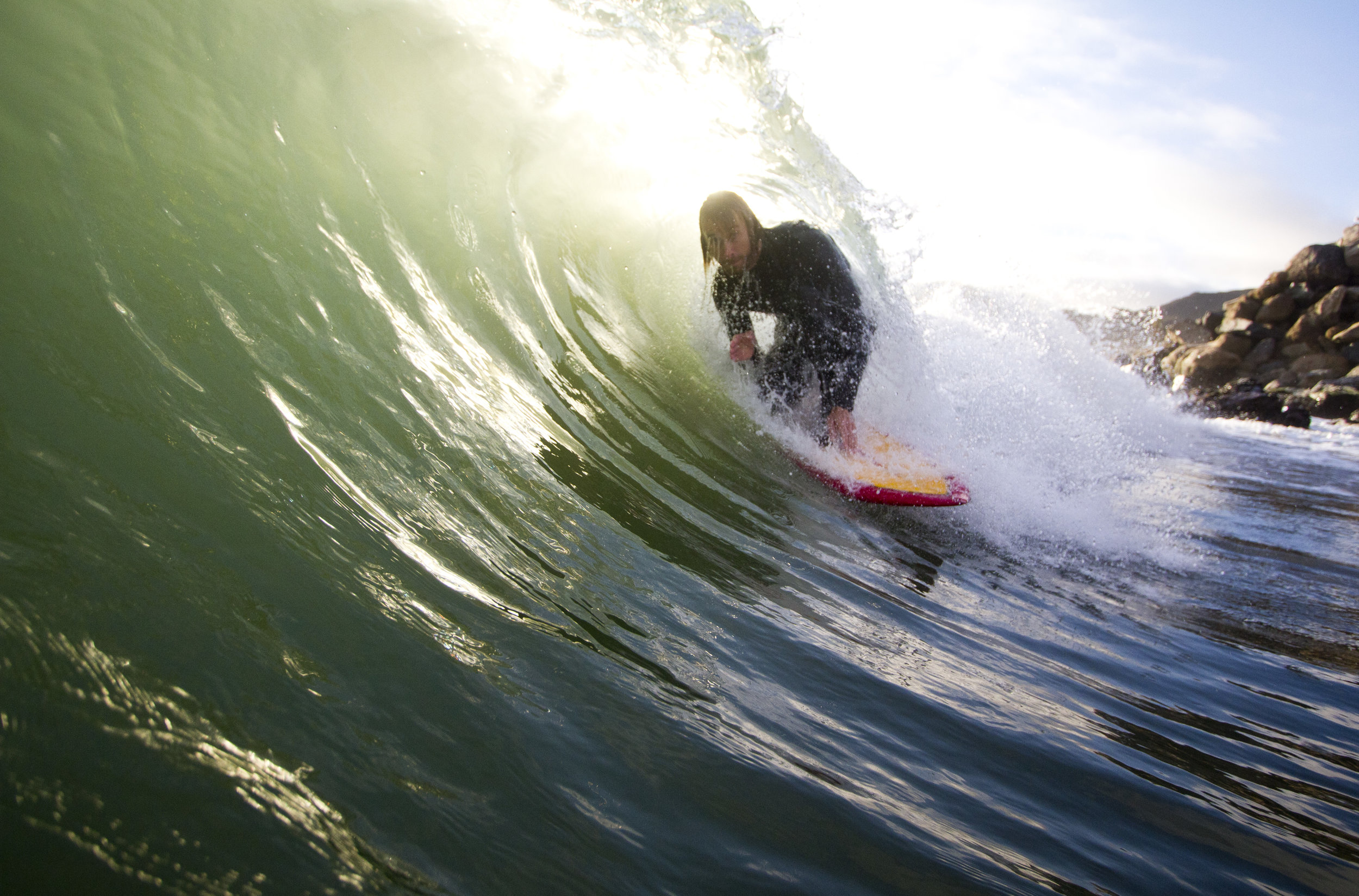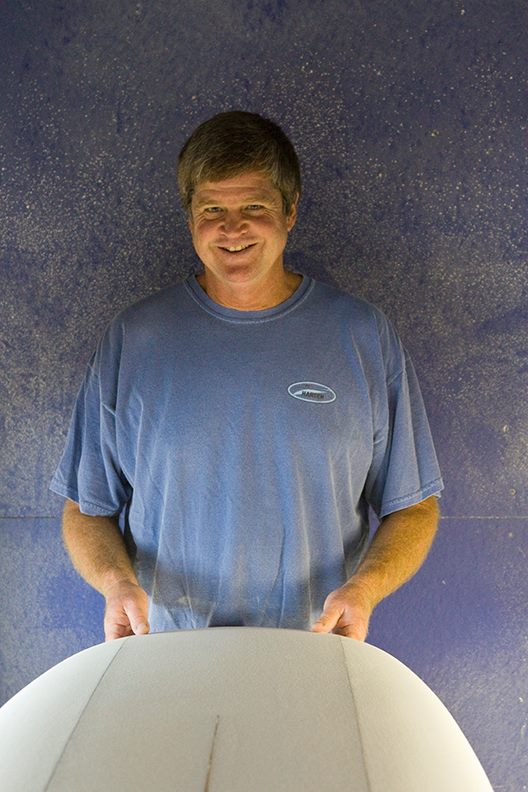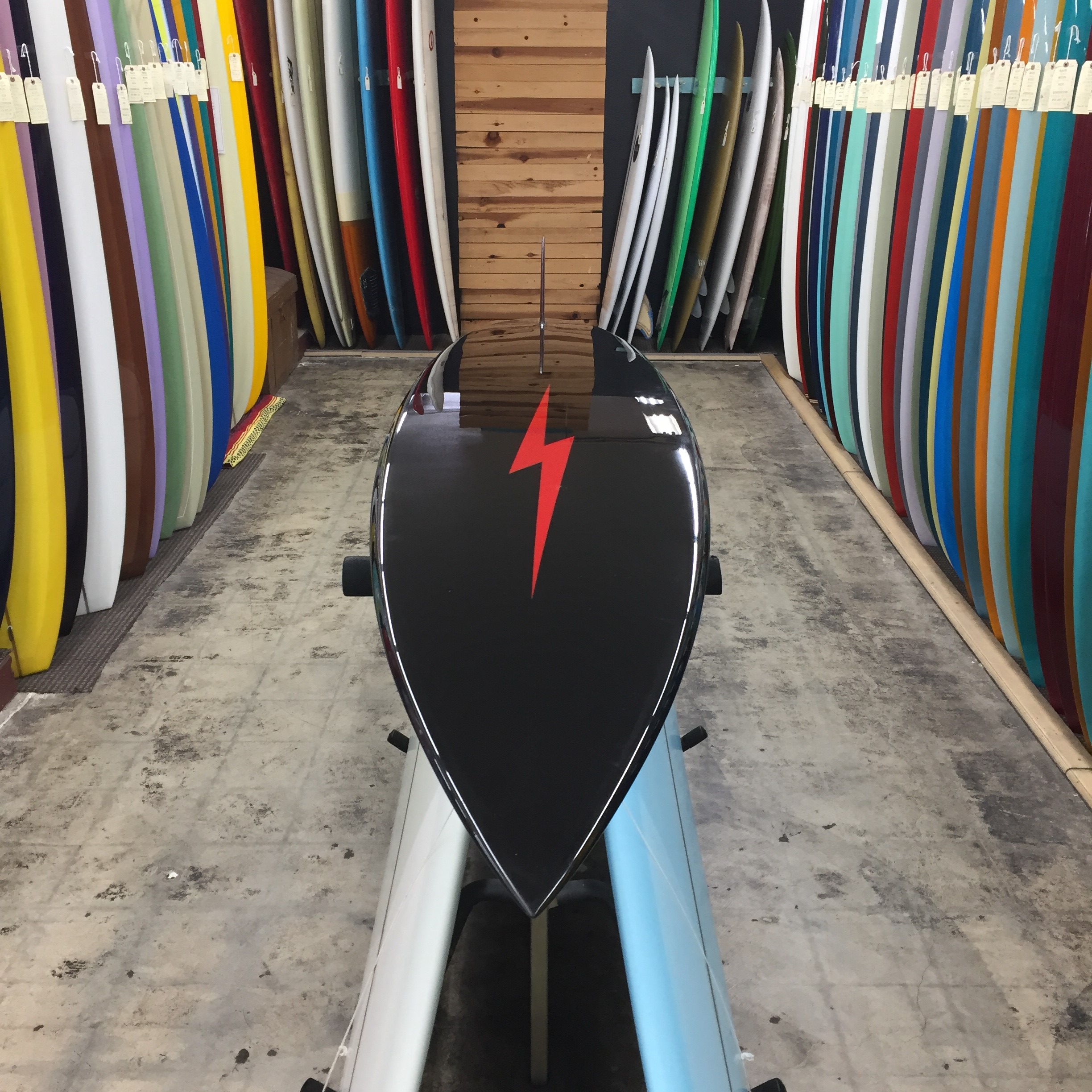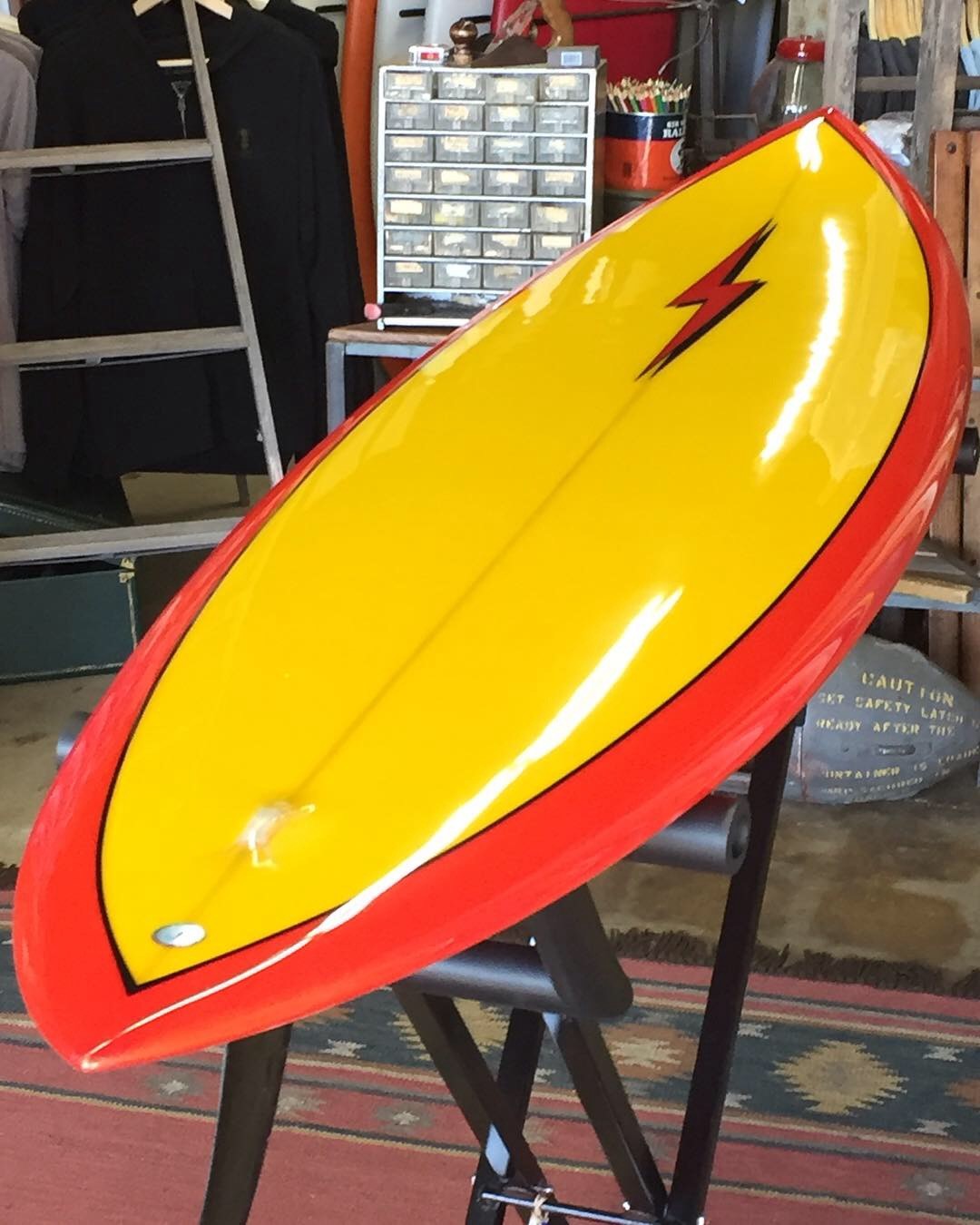INTERVIEW WITH CRAIG HOLLINGWORTH
Craig Hollingsworth has been shaping surfboards since 1973, he was born and raised in Southern California, and a world-class surfer himself. Craig has traveled the world over perfecting his designs. With his long-time experience and hands-on-approach to testing surfboard performance, Hollingsworth is one of the most versatile shapers in the world today.
Lightning Bolt has always held a reputation for amazing surfboards. With our elemental symbol centered on the stringer, each board is iconic and beautifully encapsulates a style and a grace designed to call out the innovative spirit within each surfer who rides them. Lightning Bolt boards program keeps marketing exclusively the authentic surfboards shaped only by authorized artisans.
Our friend and legendary shaper, Craig continues the quest to preserve the Bolt board program, along with our legendary and original shapers of the brand. He takes 70’s inspired shapes and melds them with modern sentiment and style in the water, offering a quiver so rippable and inspired that groms and dinos alike may bask in the glow of nostalgia… while landing an aerial so crisp it cracks a salty smile.
How did you get started building boards back in the ‘70s? What was your first shaping experience?
I got into building boards at an early age, around 14 I believe. I started building plywood belly boards (paipo boards) in Junior High School in Santa Monica and a few years later I started Glassing my own boards. Surfboards cost a lot of money for a teenager, but I wanted good quality shapes to improve my surfing. I would have Donald Takayama shape blanks for me and I would glass them myself in my garage in Del Mar. Shapes were evolving very fast back in 1974 and I wanted to try and experiment with the many new designs. At one time Donald wasn’t available to shape a new board for me, so I went to a different shaper. Unfortunately, the shaper wouldn’t listen to what a teenage kid wanted in my new shape, so I told him “Just finish it and I’ll finish it when I get home” He didn’t like the sound of this and then tried to listen to me. I took the blank home and fine-tuned it myself and decided I was going to shape my boards from that moment on.
I didn’t have a planer for my first shape, so I asked Sid Madden at Sunset Surfboards in Encinitas if he could skin (take the crust off) the blank for me, which he did. I took the blank home and shaped it with a few hand tools and then glassed it. It was a 6’10” swallow tail single fin and I sold it for $115. Not bad for my first shape. Actually, the first 21 boards I shaped weren’t for me, they were customs for friends. A pretty good start for a beginner.
And what was your relationship with the legendary surfers and shapers from the golden era. Do these relationships still inspire you today?
I was inspired by some great surfers and shapers in the ’70s, some I knew and some I didn’t know. I really was influenced by the likes of Donald Takayama, Jeff Ho, Terry Fitzgerald, Dick Brewer, Ben Aipa, Gary MacNabb, Simon Anderson, Mark Richards, and Gerry Lopez. I learned and copied different aspects of these shapers designs and tweaked them and made them my own. I am still influenced by them and I’m constantly trying to make my designs even better.
How did the opportunity to join the Lightning Bolt team come up?
21 years ago in 1998, I was approached by Hang Ten to shape their Surfboards. At the time and still am, I was shaping out of my garage in Leucadia and I didn’t want to look like a backyard shaper, so I met the brand manager at Pizza Port where I had a dozen of my boards hanging in the restaurant. The owner hired me to shape different boards from the ’60s, ’70s, ’80s and modern times to display in her restaurant. While I was being interviewed to be the shaper for Hang Ten, the brand manager noticed a Red 8’7″ Lightning Bolt “Pipeliner” that I had shaped for the display hanging from the ceiling. He turned to me and said, “We own Lightning Bolt too! You can make those too!” I thought this is even better than shaping the Hang Ten’s.
On a side story, when I was 19 and out surfing at Rocky Point… I had a guy paddle up to me and asked me who shaped my surfboard? I told him I did. He said, “You are this young and surf this good and you are shaping your own boards, you gotta come with me”. He was the sander for Lightning Bolt and took me over to Gerry’s Pipeline house to meet all the guys at Lightning Bolt. Jackie Dunn was there with his Volkswagen Ghia (still had California plates on it). And I met a lot of other players at Lightning Bolt. I ended up getting very sick and returned to California, otherwise, I may have started at Lightning Bolt a lot earlier than 1998.
Rider: Gabe Boucher
Credits: Matt Wessen on Hollingsworth Surfboards
You live fascinated by the surfing lifestyle. What is this passion based on?
I’ve always loved the Ocean and have been going to the beach since I was born. I would spend hours in the water swimming and bodysurfing at a very young age. I enjoy the feel of the water surrounding my body and the power of the ocean waves. I started belly boarding when I was 12 and surfing when I was 13. I spent as much time as I could surfing the waves and enjoying floating in the water waiting for that next wave.
Do these classic boards appeal to young people? What will a surfer be moving from a modern performance longboard to one of your retro logs experience? How does the board feel different?
More and more young people are embracing the older classic longboards than ever before. They want that feeling of the early days of surfing when life was simpler, less stressful and more laid back. Fewer crowds, more smiles! Modern performance longboards are ridden more like shortboards with quicker turns and more radical maneuvers. While the older classic single fin longboards are surfed with more finesse, style and at a more refined pace. Noseriding, positioning, sliding, and styling. The older classic style longboards are a bit more challenging to ride well than modern longboards. I think that a lot of surfers like the older single fin boards, both long and short to challenge themselves to work on their style and to improve the ride waves. Over the last 20 years or so, I’ve had customers get both single fin and 3 fin boards from me, to work on their style and how they ride the wave, not just surf the wave. They have noticed after riding the single fins, their surfing has improved when they got back on their 3 fins. The 3 fin Thruster is now 39 years old and many surfers didn’t grow up on single fins and 3 fins. So, they don’t know the feeling of how they ride and now want to experience it.
Will these unique boards work for us regular guys? What kind of person is looking for a Lightning Bolt surfboard?
We are talking about shorter retro boards now… Retro single fins, quads and twins will work for the regular everyday surfer. They did for us in the ’70s and will work now. The good thing is that we learned a lot about surfboard design in those experimental times. Template shapes, bottom contours, rail designs, fins and everything else. I learned how to shape in these experimental times and tried just about everything and I know what works well and not so well. The boards we were shaping in 1978 were so much more redefined than the shapes of 1973. I base my shapes on more of the late ’70s than early ’80s. It isn’t easy to make a retro single fin that works well in most wave conditions, but it can be done, and I believe I can do it. Many of the young shapers that are creating retro designs are unfortunately copying shapes that didn’t work well in the first place. It’s not their fault, they just didn’t experience it. A lot of it was research and development, trial and error. We learn from our experience.
With the near resurgence of the retro designs, surfers young and old, male and female are longing for that experience. These are the people looking for Lightning Bolt, the board that was instrumental of the time.
Is it still possible to apply any new knowledge to classical shapes?
Yes, I’ve been doing it for years and I’m still doing it. Back in the ’70s and ’80s, surfboard designs went through a lot of experimenting with everything! Outline, rockers, tail designs, rail contours, concaves, tri-hulls, widths, thickness, wings, stings and all sorts of things. By now, you can imagine we’ve got a lot of the different shapes and designs, more or less perfected. Here comes the big but, But… when it comes to Surfboard design, everything else is constantly changing around your surfboard. Waves size and shape, surfers ability, surfers size and shape, the age of the surfer and his or her board. So, we as surfboard shapers have to move with these changes so we can make the best board for our customers, whether they are a Pro riding Big Waves or a Grom just learning how to ride the Green part of the Wave. I am constantly fine tuning my Classic and Modern Shapes, trying to make them faster, turn quicker and easier, ride smoother and allow the surfer to ride each wave effortlessly and to their best ability.
How long does it take to make one board? How many surfboards do you make each year?
It usually takes 4 to 8 weeks to make a board, and that depends on how many extras the board has, like custom stringers, resin tints, gloss and polish and the like. A clear sanded finish can be made in a week, but there is some downtime in building a board. I don’t glass boards anymore, I just shape. When glassing a board, there is downtime between applications of resin for drying and curing. There are also many other boards being glassed and your board might wait a week before it even gets started. The same thing happens for the shaper too. There might be a bunch of people who ordered before you. These are hand made items by highly skilled craftsmen and women and they take time to build.
I don’t know how many boards I make every year, I would guess hundreds. More to come, I’m going to deliver a Black Bolt to Icons of Surf in San Clemente.
Rider: Gege Brasset
Credits: Matt Wessen with Hollingsworth Surfboards
And it’s been a successful journey… you have customers like Eddie Vedder! Tell us a bit about this…
I think it is pretty cool to have customers like Eddie Vedder! I’ve made more for various famous people, both surfers and non-surfers. Eddie bought one of my Lightning Bolts off the rack at Hansen Surfboards in Encinitas a few years back. He hand-picked one of my Lightning Bolts, how cool is that. I used to make the Trophy boards for the U.S. Open of Surfing in Huntington Beach and the Duke’s Ocean Fest on Oahu for years. It’s great knowing Surfers like Andy Irons and Rob Machado won your boards! There are some other celebrities that have gotten my boards through gifts, accomplishments or purchases are Eric Clapton, Perry Farrell, Chris Isaac, Billy Jean King, Pamela Anderson…
What's your favorite model?
My favorite board to shape is the single fin "Pipeliner". The boards I learned to shape on we're single fins, they will always be close to my heart! My favorite boards to ride are double wing swallow tail quads. They are the fastest and so quick on the turns. I Love them! 3- Fin Thrusters with a side bump or wing, with a squash or swallow tail are also great versatile boards that work in any kind of Surf, big or small, good or bad.
Which other shapers do you look up to?
Not in any particular order, but here are a few of the shapers I look up to, Ben Aipa, Donald Takayama, Jeff Ho, Terry Fitzgerald, Dick Brewer, Gerry Lopez, Mike Diffenderfer, Gary MacNabb, Bob McTavish, Don Hansen and Simon Anderson to name a few.
So, what if could order a surfboard from any shaper…
Wow! That’s a hard one. It’s like asking someone what their favorite food is. If I had to pick one, it would probably be Dick Brewer. He is a master at his craft and has influenced probably each one of the shapers I just mentioned.
And what about Lightning Bolt? What does it mean to you?
Lightning Bolt is the Star of all surfboard brands. Growing up surfing in the ’70s, Lightning Bolt was the top of the heap. Almost every top surfer was or wanted to ride Lightning Bolts! The Hawaiians, Aussies, Californians, Floridians, New Yorkers, South Africans and everyone in between. Half the photos in the Surf Magazines were of Surfers riding Lightning Bolts. Such a Cool Logo, you don’t know how many people come up to me with their stories of Lightning Bolts, from their tattoos, to scribbling them on their notebooks at school, to painting them on their own boards, to carving them in Wet Cement in San Clemente by the now Lifeguard Captain of San Clement.










